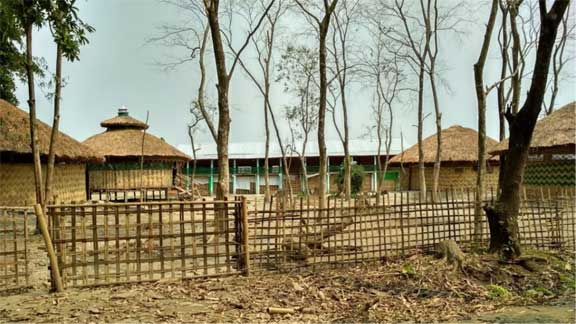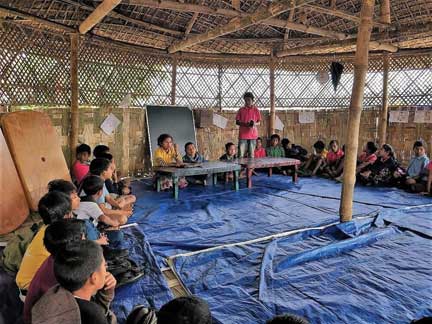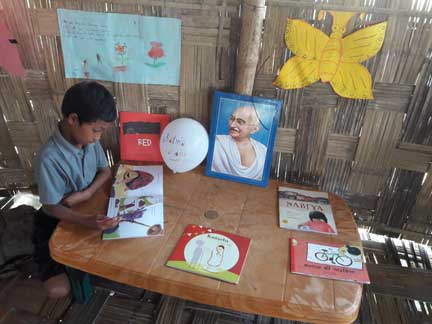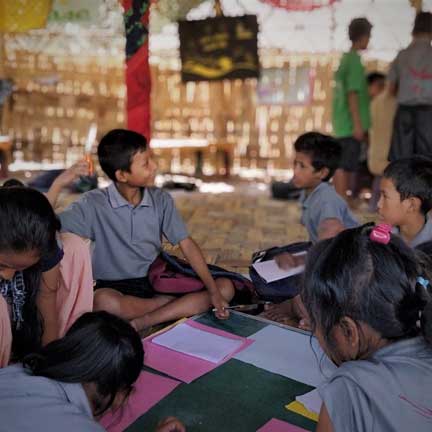Dharamjeet Kumar
I remember when I was in school we had a library and there was a fixed period for students to spend time reading in the library. I developed an attachment to the library and it continued through my life in the university. The library, for me, was not just a place for reading but a place I could escape to when I felt lonely. At school, we had a fixed period for the library, but at the university, I could spend more time there.
As a professional, when I started working in the field of education and had the opportunity to build a library, I asked myself, “Can a library be a non-judgmental space where users feel safe both physically and mentally?” This question was born out of my childhood experience with libraries. The attachment that I formed with the library had much to do with the space being non-judgmental towards me.

The Hummingbird School, run by Ayang Trust – a registered non-profit organization based in Majuli, Assam, where I work, is situated on a river island surrounded by the mighty Brahmaputra. The rich diversity of the communities that live in these dense green surroundings makes it one of the most beautiful places. However, it is also a place where most of its people spend a substantial part of the year preparing for the imminent floods, facing the floods and then recovering from the floods. For the people living here, accessing books and allocating time for reading isn’t easy, but at Ayang Trust (which works for the promotion of public education and livelihoods in the flood affected rural parts of Assam) we believe that access to books and reading is the right of every child. It is this belief that pushed us to go ahead with our library intervention programme for the school.

Considering the geographical challenges and natural vagaries that these communities have to constantly deal with, we realized that a sustainable and dynamic yet relevant library has to be collectively owned by its users. Collective ownership widens the vision of the library as it gives users an equal say in shaping the library to their liking, keeping in mind their needs. I believe that a library has to evolve as a democratic space and help in empowering the voices of the people using it.
Just when we started building our library in The Hummingbird school, I was fortunate enough to participate in a Library Educators Course (LEC) conducted by the Bookworm Trust, Goa. During the course, I was introduced to a paper by Ivanka Stricevic (a Croatian writer who is a strong advocate of public libraries). Reading this paper expanded my vision of libraries. In her paper (Stricevic, 2000), Stricevic writes how during the Croatian war, the library (citing the example of libraries in Croatia’s capital, Zagreb) became a shelter, particularly for children; they became much more than a physical space as they fulfilled the psychological and emotional needs of the people who used it during the difficult times. I was also inspired by Usha Mukunda’s (co-founder of Centre For Learning, Bangalore and a mentor on the LEC course) definition of the ownership of the library. Mukunda says, “In an open library, all users are owners of the library. They are responsible for all aspects of the library, its collection, and its use. This is seen in the framing of agreements and contracts regarding the running and use of the library.” (Mukunda, 2016)

As part of the field project for my course, I decided to explore this question of access and ownership in a school library with my own primary school students as my subjects. How can young children develop a sense of shared ownership about the library and why is it important. Before moving to the main library, I decided to start small and first chose to work with my students in the classroom library.

For their classroom library, I carefully selected a set of books suitable for young readers. All the books had a strong component on ownership. There were 10 sessions as part of the study and the sessions were designed to raise discussions on ownership and encourage students to be responsible for and take up independent initiatives in the library.
Since my participants were very young children, they were naturally very energetic. On several occasions, I had to calm them down so that they could think and reflect on the sessions. Activities like making library cards, entering the names of the books on the cards, drawing and storytelling brought that much needed stillness and moments of thoughtfulness. Every session was followed by a discussion on ownership. I noticed the developing ownership among the children through their library cards, the drawings on the walls, display of books that they made and the rules of the library that they put together.

Over time, my belief in collective ownership further strengthened. However, I realized that for the readers to continue valuing their ownership of the library there should be opportunities for the ownership to be engaged, appreciated and celebrated. When we choose to operate a library this way, it changes many conventional beliefs about libraries.
We integrated dance, songs, poetry, and theater as regular events for the library. The community in Majuli has a rich tradition of folk songs, dance and theater. These art forms have historical importance and they continue to be part of the identity of the communities. Through bringing the arts alive in the library we had the presentation of texts based on them which opened for meaningful engagement by children. As context-based literature, local art and crafts were brought into the library, it helped further strengthen the sense of ownership among the children.
Looking back on the entire effort of building a shared ownership of the library, I think we could have worked on the school curriculum to allocate more time during the school hours for the students to spend time in the library. We should have involved them in deciding library timings and purchasing the books for the library as well. I also think we could have had sessions with the parents about the library, making them aware of how their children are participating in the school library.
For young children, as they start to explore more stories in the world and relate their own stories with others, the librarian’s role becomes important in facilitating their exploration and sustaining co-ownership of the space. Being a facilitator, I have experienced the tremendous curiosity and excitement among young readers and the readiness to take responsibility of a shared space for learning and growing.
Books selected for the sessions were –
• I will save my Land (By Rinchin)
• The Why-Why Girl (By Mahasweta Devi)
• Satyadas (By Bimal Kar)
• Ismat’s Eid (Fawzia Gilani)
References
- Mukunda, U. (2016). The Open Library – Some thoughts.
- Stricevic, I. (2009). Bringing Books and Children Together: Croatian War Experiences. Bookbird: A Journal of International Children’s Literature, Volume 47, Number 4, pp. 9-19.
The author is a co-founder of Ayang Trust. Ayang Trust runs a school called the Hummingbird School in Majuli, Assam and also works in the area of livelihood and promotion of libraries. He can be reached at dharamjeeth.k@gmail.com.
